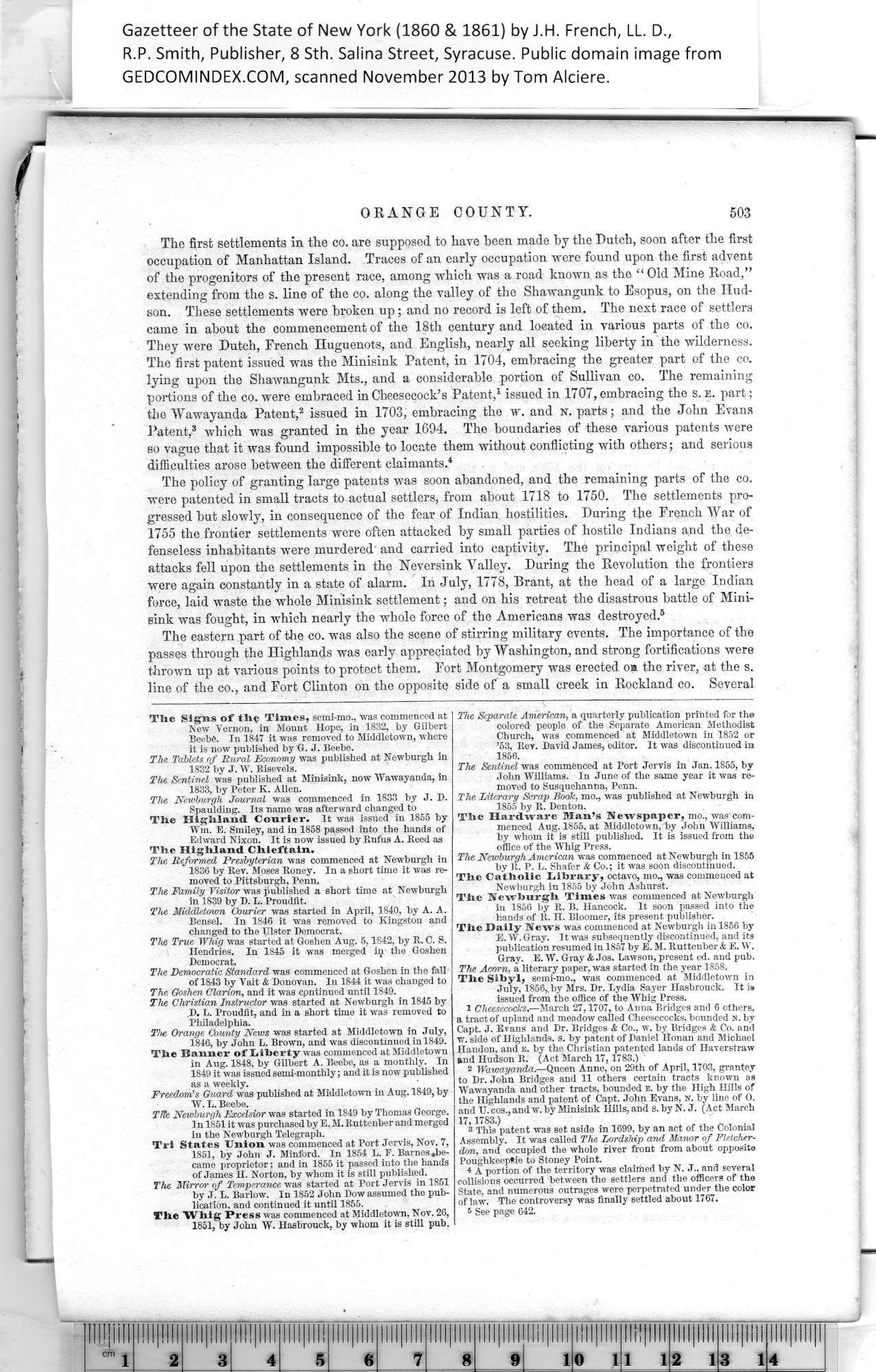|
The Signs of thv Times, semi-mo., was commenced at
New Vernon, in Mount Hope, in 1832, by Gilbert
Beebe. In 1847 it was removed to Middletown, where
it is now published by G. J. Beebe.
The Tablets of Rural Economy was published at Newburgh in
1832 by J. W. Bisevels.
The Sentinel was published at Minisink, now Wawayanda, in
1833, by Peter K. Allen.
The Newburgh Journal was commenced in 1833 by J. D.
Spaulding. Its name was afterward changed to
The Highland. Conrier. It was issued in 1855 by
Wm. E. Smiley, and in 1858 passed into the hands of
Edward Nixon. It is now issued by Rufus A. Reed as
The Highland Chieftain.
The Reformed Presbyterian was commenced at Newburgh in
1836 by Rev. Moses Roney. In a short time it was re¬
moved to Pittsburgh, Penn.
The Family Visitor was published a short time at Newburgh
in 1839 by D. L. Proudfit.
The Middletown Courier was started in April, 1840, by A. A.
Bensel. In 1846 it was removed to Kingston and
changed to the Ulster Democrat.
The True Whig was started at Goshen Aug. 5,1842, by R. C. S.
Hendries. In 1845 it was merged in the Goshen
Democrat.
The Democratic Standard was commenced at Goshen in the fall
of 1843 by Vait & Donovan. In 1844 it was changed to
The Goshen Clarion, and it was cpntinued until 1849.
The Christian Instructor was started at Newburgh in 1845 by
D. L. Proudfit, and in a short time it was removed to
Philadelphia.
The Orange County News was started at Middletown in July,
1846, by John L. Brown, and was discontinued in 1849.
The Banner of Liberty was commenced at Middletown
in Aug. 1848, by Gilbert A. Beebe, as a monthly. In
1849 it was issued semi-monthly; and it is now published
as a weekly.
Freedom’s Guard was published at Middletown in Aug. 1849, by
W. L. Beebe.
Tlte Newburgh Excelsior was started in 1849 by Thomas George.
In 1851 it was purchased by E. M. Ruttenber and merged
in the Newburgh Telegraph.
Tri States Union was commenced at Port Jervis, Nov. 7,
1851, by John J. Minford. In 1854 E. E. Barnes .be¬
came proprietor; and in 1855 it passed into the hands
of James H. Norton, by whom it is still published.
The Mirror of Temperance was started at Port Jervis in 1851
by J. D. Barlow. In 1852 John Dow assumed the pub¬
lication, and continued it until 1855.
The Whig Press was commenced at Middletown, Nov. 26,
1851, by John W. Hasbrouck, by whom it is still pub. |
The Separate American, a quarterly publication printed for tho
colored people of the Separate American Methodist
Church, was commenced at Middletown in 1852 or
’53, Rev. David James, editor. It was discontinued in
1856.
The Sentinel was commenced at Port Jervis in Jan. 1855, by
John Williams. In June of the same year it was re¬
moved to Susquehanna, Penn.
The Literary Scrap Book, mo., was published at Newburgh in
1855 by R. Denton.
The Hardware filaii’s Newspaper, mo., was com¬
menced Aug. 1855, at Middletown, by John Williams,
by whom it is still published. It is issued from the
office of the Whig Press.
The Newburgh American was commenced at Newburgh in 1855
by R. P. L. Shafer & Co.; it was soon discontinued.
The Catholic Library, octavo, mo., was commenced at
Newburgh in 1855 by John Ashurst.
The Newburgh Times was commenced at Newburgh
in 1856 by R. B. Hancock. It soon passed into the
hands of 11. H. Bloomer, its present publisher.
The Daily News was commenced at Newburgh in 1856 by
E. W. Gray. It was subsequently discontinued, and its
publication resumed in 1857 by E. M. Ruttenber & E. IV.
Gray. E. W. Gray & Jos. Lawson, present ed. and pub.
The Acorn, a literary paper, was started in the year 1858.
The Sihyl, semi-mo., was commenced at Middletown in
July, 1856,. by Mrs. Dr. Lydia Sayer Hasbrouck. It is<
issued from the office of the Whig Press.
1 Cheesecocks.—March 27,1707, to Anna Bridges and 6 others,
a tract of upland and meadow called Cheesecocks, bounded sr. by
Capt. J. Evans and Dr. Bridges & Co., w. by Bridges & Co. and
w. side of Highlands, s. by patent of Daniel Honan and Michael
Handon, and e. by the Christian patented lands of Haverstraw
and Hudson R. (Act March 17,1783.)
2 Wawayanda.—Queen Anne, on 29th of April, 1703, grantey
to Dr. John Bridges and 11 others certain tracts known as
Wawayanda and other tracts, bounded e. by the High Hills of
the Highlands and patent of Capt. John Evans, w. by line of O.
and U. cos., and W. by Minisink Hills, and S. by N. J. (Act March
17,1783.)
2 This patent was set aside in 1699, by an act of the Colonial
Assembly. It was called The Lordship and Manor of Fletcher-
don, and" occupied the whole river front from about opposite
Poughkeepsie to Stoney Point.
4 A portion of the territory was claimed by N. J., and several
collisions occurred between the settlers and the officers of the
State, and numerous outrages were perpetrated under the color
of law. The controversy was finally settled about 1767.
6 See page 642. |
